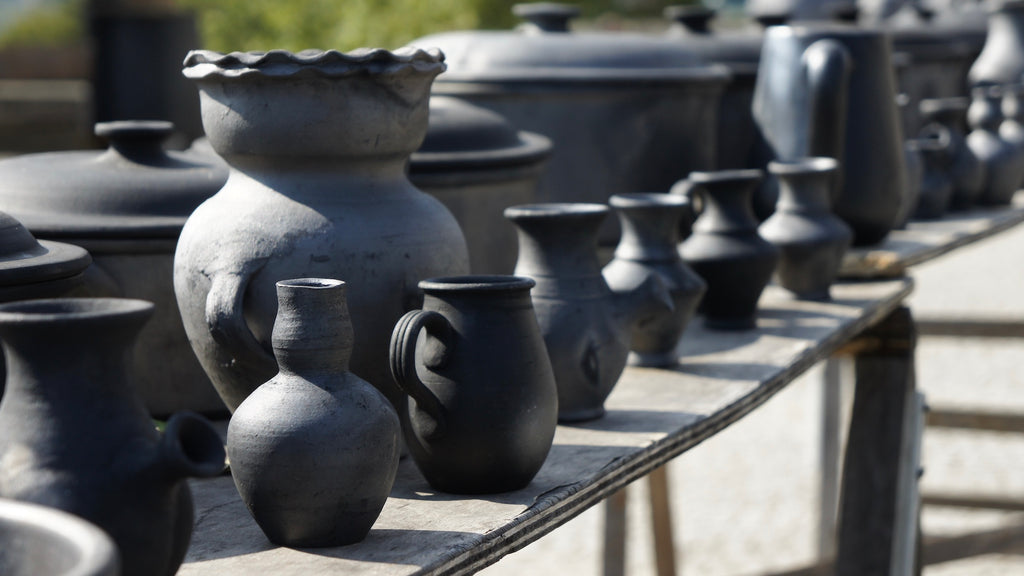Perhaps you have never heard of the village of Bisalhães. This small mountain village located in the municipality of Vila Real has a specificity: its artisans produce black clay, called "black pottery of Bisalhães".
In November 2016, UNESCO declared this art intangible cultural heritage. However, this tradition remains on the way to extinction. Of the artisans who knew the secrets of this art, only five remain.

The black earthenware of Bisalhães is a cultural patrimony that belongs, by right, to the inhabitants of Bisalhães, by love, to the population of Vila Real. After classification by UNESCO, it belongs to the whole Humanity.
So we set out to find this heritage and, for that, we looked for its source: the village of Bisalhães.
In search of the black pottery of Bisalhães
To find the black pottery of Bisalhães is frankly not simple. You have no choice but to go there.
To get to Bisalhães, you first have to go to the city of Vila Real in the North of Portugal in the old region of Trás-os-Montes e Alto Douro, about 100 kilometers from Porto, not far from the Spanish border.

Once in Vila Real, the best thing to do is to go to Avenida da Noruega. There you can see the 4 or 5 permanent stands set up by the municipality and meet the few potters who present their work there. Then ask them to show you the way to Bisalhães, which is about 10 km away.

Bisalhães is a small and unexpected village as it still exists in Portugal. To tell the truth, the term of village is improper, it is appropriate to speak about a hamlet gathering some houses.
No inhabitant in sight, a few stray dogs, a single twisted street, a few paths and at the bend of one of them, a large black trace on the ground and some stones testify to the existence of a "soenga", a typical clay oven of the Bisalhães process.

In fact, it is a community oven, simply dug into the ground and shared by the 5 potters who remain the only holders of the secrets of making black pottery.
This village has been known since the 16th century as the "Land of the pot and dish makers".
The pottery making processes used here for more than 5 centuries are unique and are only mastered today by 5 potters. This is the reason why Vila Real, the nearest town, became concerned and asked UNESCO to include this process in the list of the world intangible heritage.
* In August 2021, in the middle of the tourist season, we returned to Vila Real and Bisalhães. All the potters' stands were closed except for the one of the Ramalho family. Jorge recognized us and welcomed us to announce the death of his father whom we had met 2 years before. Jorge has taken over and, with the help of the City Council, continues to produce black pottery, but it seems that he is the only one and that the black pottery of Bisalhães is definitely threatened with extinction.
The manufacturing process of black pottery
For 5 centuries, the methods of manufacture have remained the same and the pieces manufactured remain unchanged.
The pieces that are born from the hands of the artisans are cooked in old open ovens in the earth, where broom, caruma and carquejas are burned and then smothered with black earth, the same that will give them their color. Some people even say that this gives a different taste to the food.
The preparation of the clay
The clay is crushed in a stone basin by means of a wooden hammer in order to make it as fine as possible. The clay is then sifted, manually, in order to extract the impurities and the pieces which would harm the solidity of the realized pieces. It is finally moistened and kneaded to form a large ball ready to be turned.

The manufacture of potteries.
The clay is shaped on a slow wheel. All pieces are turned by hand, so no two are alike: dimensions and shapes are completely unique. After drying, the resulting piece is traditionally polished with pebbles and decorated with a simple wooden stick.


The firing
In a collective family work, with a lot of ancestral wisdom, the pieces are placed, from the largest at the bottom to the smallest at the top, all duly laid down and covered with broom, carumas, carquejas.
When the potter decides, this process is completed and the whole pile is covered with earth, so that for several hours there is no escape of smoke or entry of oxygen, to ensure that the black color is a reality.

Credit : Who trips

Credit : Who trips

A disappearing heritage
Over the decades, the local community has not taken charge of the transmission of knowledge to new generations.
The arduous work necessary to the manufacturing process of the black earthenware of Bisalhães (transport, collection of the raw material, preparation of the pieces, firing process and sale), the traditional division of tasks, with the intervention of women, the little social valorization of this art, leads the young generations, to emigrate, in search of new ways of life.

The small number of potters and the difficulties manifested in this process, led to this important step, the recognition by UNESCO. Thus, on November 29, 2016, the manufacturing process of the blackware of Bisalhães was included in the list of cultural heritage requiring urgent safeguarding.
In 2018, during our first visit to Bisalhães we counted only five potters, already very old, two of whom were practically no longer able to work.
When we returned in 2021, we could only meet one potter, Jorge, who had just taken over from his recently deceased father. It seems that the black pottery of Bisalhães is now in the process of total extinction.
Sezinando Ramalho
In 2018, we met Sezinando Ramalho who explained to us that he got his technique from his father. He was one of the last 5 potters to master the art of black pottery from Bisalhães and was working hard to defend its history, heritage and technique. He tried to renew the style of the pieces he produced without making any concession to his own technique.
Thus, he had, in collaboration with a young designer, conceived abats jours which joined one of the fashionable restaurants of Lisbon. He also agreed to adapt the dimensions of some of these pieces at the request of a Japanese importer who sold them at a high price.

In 2021, it is with a sad heart that we learned of his death. With him disappears another face of Bisalhães, who dedicated so much of his life, his hands and his love to this ancestral art.
Hope for the black pottery of Bisalhães ?
Hope comes from Jorge Ramalho, Sezinando's son, a promising potter who, with perseverance, continues to give life to the Pottery of Bisalhães. It is his pottery that you can find on sale on the website Luisa Paixâo






